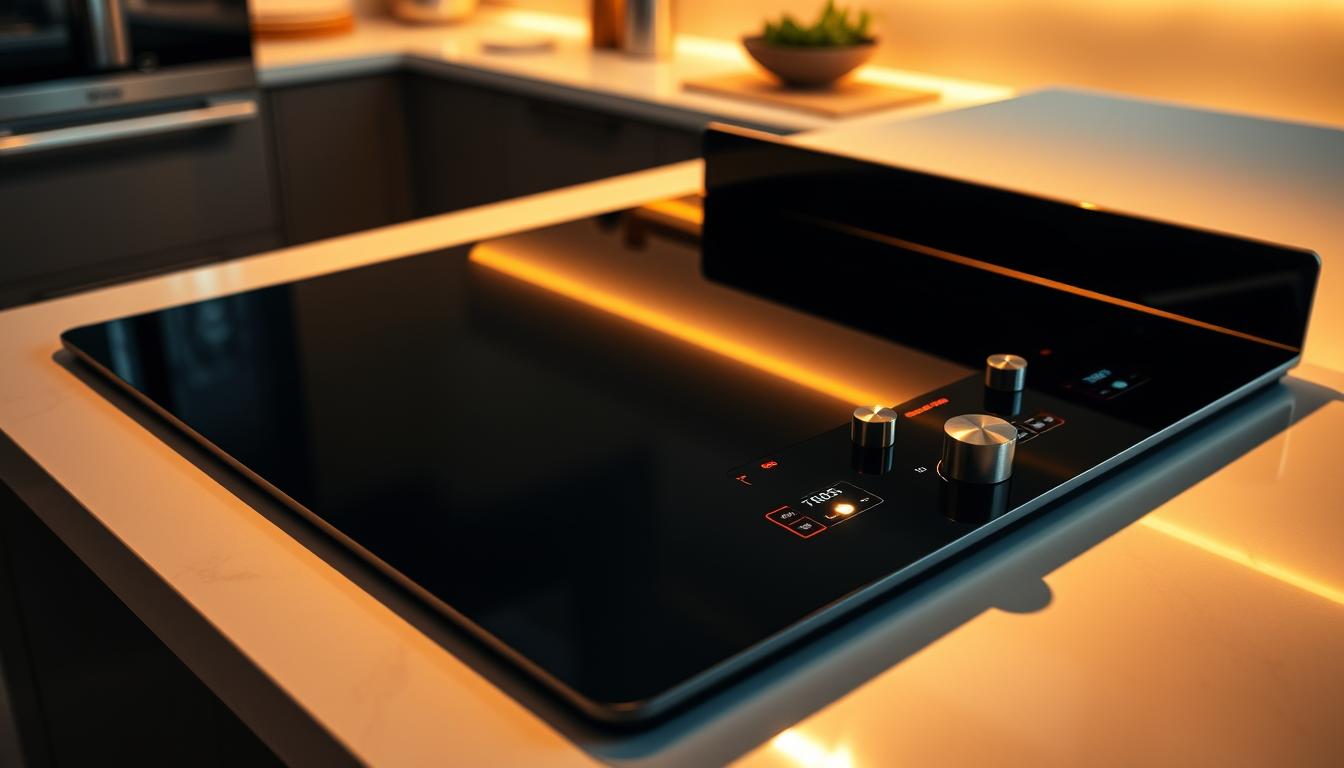Modern kitchens now harness technology 85% more energy-efficient than gas burners. This breakthrough doesn’t involve flames or glowing coils – it uses electromagnetic principles to heat pans in seconds.
At the core of this innovation lies a copper coil beneath your cooktop surface. When activated, it creates a magnetic field that directly energizes compatible cookware. Unlike traditional methods, heat forms inside your pan rather than transferring through intermediate surfaces.
This process eliminates wasted energy while offering precise temperature control. Commercial kitchens report 40% faster boiling times compared to conventional electric ranges. Home chefs appreciate immediate adjustments similar to gas systems, but with easier cleanup and safety features.
Key Takeaways
- Uses electromagnetic energy instead of direct flames or radiant heat
- Heats cookware directly through magnetic field interaction
- Operates 2-3 times faster than traditional electric stoves
- Reduces energy waste by heating pans instead of surfaces
- Combines gas-like control with electric-style ease of cleaning
- Requires magnetic cookware for proper functionality
Introduction to Induction Cooking
A quiet revolution transforms American kitchens as electromagnetic innovation replaces conventional methods. While European chefs perfected this approach over 30 years ago, U.S. households now recognize its potential for safer, faster meal preparation.

The rise of induction technology in the United States
American home cooks initially hesitated to adopt this technology due to cost and cookware requirements. Recent energy concerns and technological advancements changed this mindset. Sales surged 28% last year as consumers sought eco-friendly alternatives to gas ranges.
Major appliance brands now prioritize induction models in their U.S. product lines. This shift aligns with growing environmental awareness – electromagnetic systems waste 40% less energy than traditional electric coils.
How induction differs from traditional cooktops
Gas ranges produce flames that heat air around pans, while electric models glow red-hot to transfer energy. Induction bypasses both methods by creating magnetic vibrations in compatible cookware. Your skillet becomes the heat source, eliminating wasted energy on empty burner surfaces.
Safety improvements stand out immediately. Without open flames or scorching elements, accidental burns decrease significantly. You can place a paper towel between the cooktop and pan without ignition risks – a feat impossible with gas or conventional electric systems.
Understanding How Induction Cooking Works
When you power on an induction cooktop, electricity courses through a tightly wound copper coil beneath its smooth surface. This action generates a fluctuating magnetic field that penetrates compatible pans. Unlike traditional methods, heat forms within your cookware through electromagnetic excitement.

The science behind electromagnetic energy
Alternating current drives the system. As electrons race through the copper coil, they create invisible magnetic waves. These waves induce swirling electrical currents (eddy currents) in ferromagnetic pans. Your skillet’s iron molecules resist this movement, generating instant friction-based warmth.
This process skips intermediate steps. Gas burners heat air, electric coils glow red – but induction targets your pan directly. The surface stays cool because energy transfers through magnetic force, not thermal conduction.
Core elements driving performance
Three components make the magic happen:
| Component | Role | Impact |
|---|---|---|
| Copper coil | Generates magnetic field | Determines heating speed |
| Magnetic field | Activates cookware | Ensures safety & efficiency |
| Ferrous cookware | Converts energy to heat | Enables precise temperature control |
Your pots become active participants. Only magnetic-grade cookware completes the circuit – test yours with a fridge magnet. This selective activation prevents energy waste, as unused zones remain inactive.
Advanced models adjust magnetic frequency up to 50,000 times per second. This lets you simmer sauces at 180°F or sear steaks at 450°F with gas-like responsiveness. Instant adjustments occur because changing current flow modifies field strength immediately.
How Induction Cooking Works
Your kitchen becomes a precision workspace with electromagnetic technology. The smooth surface stays cool even during intense meal preparation – place your palm directly on it while sautéing vegetables. Only compatible pans heat up, transferring warmth through magnetic interaction rather than thermal conduction.

- Automatic shutdown when removing pans prevents accidental activation
- No residual heat after turning off the burner
- Child lock settings override unintended adjustments
Boil water in half the time compared to gas ranges. Adjust temperature instantly – reduce from rolling boil to gentle simmer with one touch. This responsiveness stems from direct energy transfer, bypassing traditional heating elements entirely.
Energy efficiency peaks at 85% compared to gas’s 40%. Your control extends beyond dials – electromagnetic fields adapt 50,000 times per second for consistent results. Cast iron skillets and stainless steel pots distribute heat evenly, eliminating cold spots common in conventional setups.
Flame-free operation minimizes fire risks while simplifying cleanup. Spills won’t bake onto burner surfaces, maintaining a professional-grade appearance effortlessly.
The Benefits of Energy Efficient Cooking
Transformative kitchen upgrades now prioritize both performance and sustainability. Electromagnetic technology delivers measurable improvements that impact your utility bills, cooking experience, and environmental footprint.

Faster Heating and Precise Temperature Control
Your pans reach boiling point 50% faster than gas systems. ENERGY STAR confirms these appliances use three times less energy while outperforming traditional models. Immediate adjustments let you switch from searing meats to melting chocolate without waiting for burner cooling.
Precision comes from direct magnetic interaction. You control exactly how much energy enters your cookware – no more guessing with dials. Commercial chefs report 2-second response times when lowering temperatures for delicate sauces.
Enhanced Energy Efficiency Compared to Gas and Electric
Traditional stoves waste energy heating air around pans. Induction models channel 85% of power directly into food preparation. This translates to 30-50% lower energy use than gas alternatives, as verified by Department of Energy studies.
Your kitchen stays cooler since surfaces don’t radiate excess heat. This efficiency extends beyond savings – reduced emissions make these cooktops eco-friendly choices.
“The direct transfer method sets new standards for sustainable cooking,”
notes a recent ENERGY STAR report.
Yearly savings add up quickly. Families typically recoup upgrade costs through lower utility bills within 3 years. Combined with faster meal prep, these benefits make electromagnetic technology a smart long-term investment.
Induction Cooktop Versus Gas and Electric Cooking
Kitchen upgrade decisions increasingly hinge on safety and environmental impact. Recent studies reveal startling facts about traditional cooking methods, pushing homeowners toward cleaner alternatives.

Comparing efficiency and safety
Gas cooktops pose hidden risks beyond visible flames. Stanford researchers found year-round methane leaks equivalent to 40 miles of car emissions per stove. “Even inactive units emit formaldehyde and carbon monoxide,” their 2022 report states.
| Feature | Induction | Gas | Electric |
|---|---|---|---|
| Surface temperature | Cool | Extreme heat | Slow cooling |
| Energy efficiency | 85% | 40% | 75% |
| Boil time (1L water) | 3 mins | 5 mins | 7 mins |
Your kitchen air stays cleaner with induction technology. No gas combustion means zero nitrogen dioxide – a key trigger for respiratory issues. Automatic shutoff features prevent accidental burns common with electric coils.
Switching cuts energy costs immediately. Magnetic systems waste 45% less power than gas alternatives. You’ll notice faster boiling times and precise simmer control, matching professional-grade performance.
“Methane emissions from gas stoves have climate impacts comparable to 500,000 gasoline cars annually.”
Families report fewer asthma incidents after replacing gas units. The cool surface prevents curious toddlers from burns, while instant pan detection eliminates forgotten pots.
Essential Considerations When Switching to Induction
Transitioning to advanced kitchen tech requires smart preparation. Focus on two critical factors: your existing equipment and home infrastructure. Proper planning ensures seamless adoption of this efficient cooking method.
Cookware compatibility: determining if your pans are suitable
Test your pans with a refrigerator magnet. If it clings firmly, you’re ready to cook. Materials like cast iron and stainless steel naturally work best due to their magnetic properties.
Flat-bottomed cookware ensures optimal contact with the surface. Warped pots create air gaps that reduce heating efficiency. Consider replacing older items that fail the magnet test – look for “induction-ready” labels when shopping.
Electrical requirements and installation tips
Most models need dedicated 240-volt circuits similar to electric dryers. Portable units often use standard 120-volt outlets. Check your breaker panel’s capacity before purchasing.
Upgrading from gas ranges typically costs more. You’ll need licensed professionals to install new wiring and cap gas lines. Existing electric setups usually require minimal modifications, cutting installation expenses.
Quality cookware enhances performance but isn’t mandatory. Many households already own compatible pans – that trusty skillet might work perfectly. Prioritize verifying what you own before buying new items.
Cooking Techniques Tailored for Induction
Mastering electromagnetic cooktops transforms your culinary approach. These systems demand fresh strategies to harness their speed and precision effectively.
Sync with rapid heat response
Your first meals might surprise you. Ingredients cook faster than traditional methods – onions caramelize in minutes, not 20. Keep prep work ready before heating pans. Chop vegetables while proteins rest, not during active cooking phases.
Optimize magnetic cookware performance
Cast iron excels with even heat distribution. Ensure flat-bottomed pans make full contact – wobbling reduces efficiency. For cast iron skillet sets, preheat gradually to avoid hotspots. Stainless steel requires moderate oil to prevent sticking.
Lower temperatures often achieve better results. Simmer sauces at power level 3 instead of 5. Residual heat continues cooking after shutdown – remove food promptly for perfect doneness.
Embrace these adjustments to unlock faster meal prep and consistent results. Your upgraded kitchen workflow matches professional efficiency while reducing energy waste.



